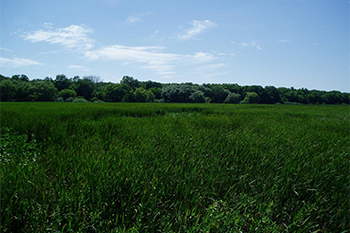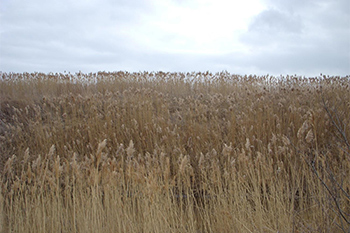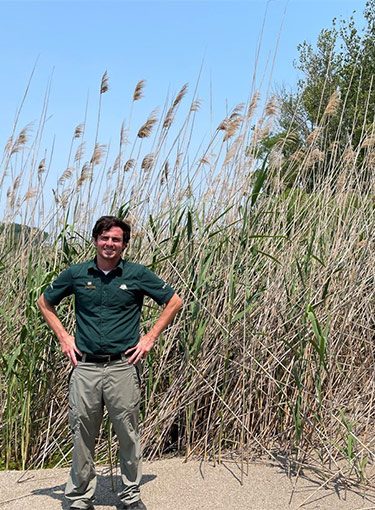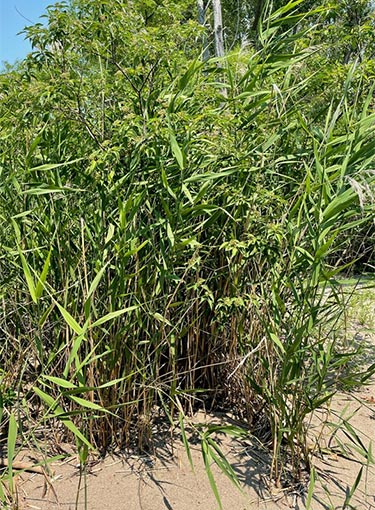What is causing the decrease in open water?
Point Pelee National Park
Invasive plant species have led to the decrease in marsh habitat diversity at Point Pelee National Park, including the infilling of the channels and ponds. Invasive blue cattail (Typha x glauca), narrow-leaf cattail (Typha angustifolia) and European Common Reed or invasive Phragmites (Phragmites australis australis) grow aggressively, outcompeting native species and creating dense monocultures (an area with only one species). These monocultures spread into open water areas, replacing the mosaic of open water and edge habitats with a singular, unproductive habitat.
Invasive Cattail: Blue Cattail and Narrow-leaf Cattail

Cattails are aquatic plants that can grow up to three feet in height, and are recognizable by their downy, cigar-shaped seed heads. Growing in dense mats that cover much of the marsh, they are a familiar sight to park visitors.
Native cattail has always been important to the marsh, providing crucial protection, feeding, and nesting opportunities for species, while at the same time promoting balanced open water habitat. Then invasive cattails arrived and dramatically changed the face of the marsh. Invasive narrow-leaf cattail (Typha angustifolia) was likely introduced to North America along the Eastern seaboard during European settlement. During the 19th century, this species spread, crossbreeding with native broad-leaf cattail (Typha latifolia). The resulting hybrid species, blue cattail (Typha x glauca), grows invasively across both shallow and deeper water habitats, creating dense stands that eliminate open water and decrease biodiversity. Since 1960, invasive and hybrid cattail-dominated habitat has decreased open water habitat by 10%. Habitat shifts caused by invasive cattail are not limited to open water areas, having also replaced native and diverse grass and sedge shallow marsh in large areas throughout Point Pelee National Park.
European Common Reed (Phragmites australis australis)

Phragmites australis subspecies australis, or European Common Reed, is a tall, exotic, and invasive perennial grass that can be found in wetlands, ditches, lakeshores, and other shallow aquatic environments. It was introduced to North America in the 1800s, where it aggressively spread across the continent. It was named Canada’s “worst” invasive plant species by Agriculture and Agri-food Canada in 2005, as its effects range from impacting recreational activities to decreasing biodiversity.
Invasive Phragmites is able to grow up to 5 metres in height and have a density of 200 stems per square meter. By growing densely, quickly, building up dead biomass, and releasing toxins from its roots, it can outcompete other plants through shading and resource competition. As plant biodiversity decreases, so does animal diversity, creating a more uniform ecosystem. The habitat provided by Phragmites stands is not equal to the habitat they have replaced, and the density of monocultures they form pose challenges to wildlife in itself. For instance, invasive Phragmites has been found to be a problem for turtle species, including species at risk Blanding’s turtles. These turtles travel across land each year to return to their nesting sites, and Phragmites plants not only reduce the suitability of nesting sites themselves by shading ground material, but also become an obstacle to the turtles as they attempt to reach these sites.
Native Phragmites
Not all Phragmites are exotic or invasive. Another subspecies found in the park, American Common Reed (Phragmites australis subspecies americanus), is native to North America. Though the two subspecies are similar in appearance, they can typically be distinguished from one another using a combination of characteristics. These include, but are not limited to:
| Characteristic | Native subspecies | Invasive subspecies |
|---|---|---|
| Stem colour/texture | Smooth, shiny, reddish | Rough, dull, green |
| Leaf colour | Yellowish-green | Bluish-green |
| Seed heads | Sparse, delicate, and ripen early in the season | Fuller, heavier, and ripen later in the season |
| Growth habit | Mixed with other plants | Dense monocultures |
The native subspecies is not a threat to the ecosystem, since it does not grow in the aggressive manner of the invasive subspecies.


Above are two pictures comparing invasive and native Phragmites. In the picture on the left, a park staff member stands in front of an invasive Phragmites stand, which towers over him, In the right picture, a stand of native Phragmites is intermixed with other plant species.
- Date modified :